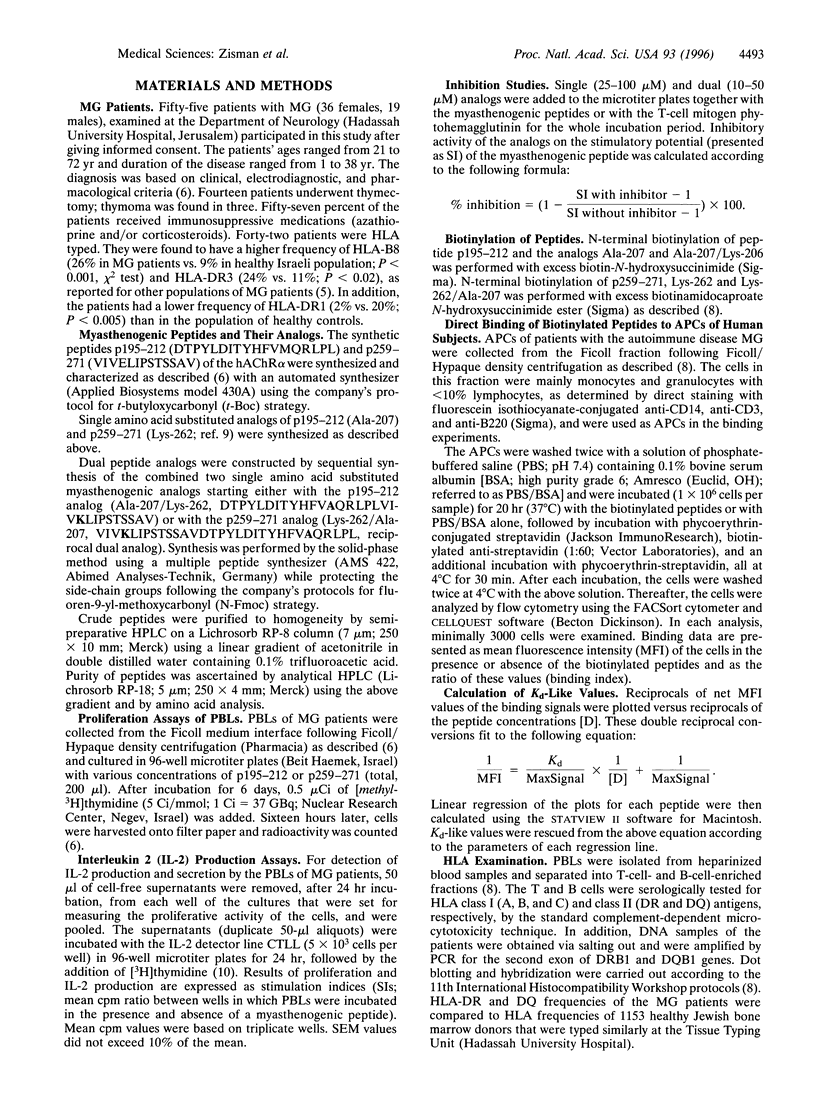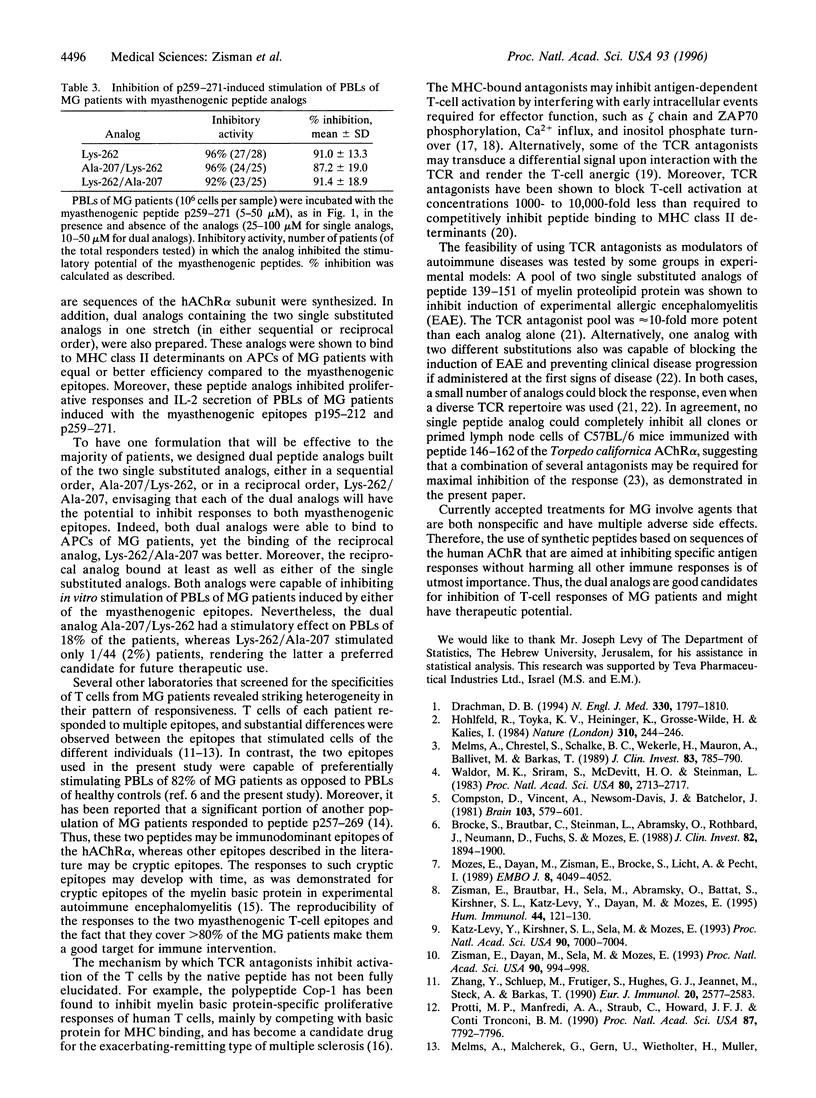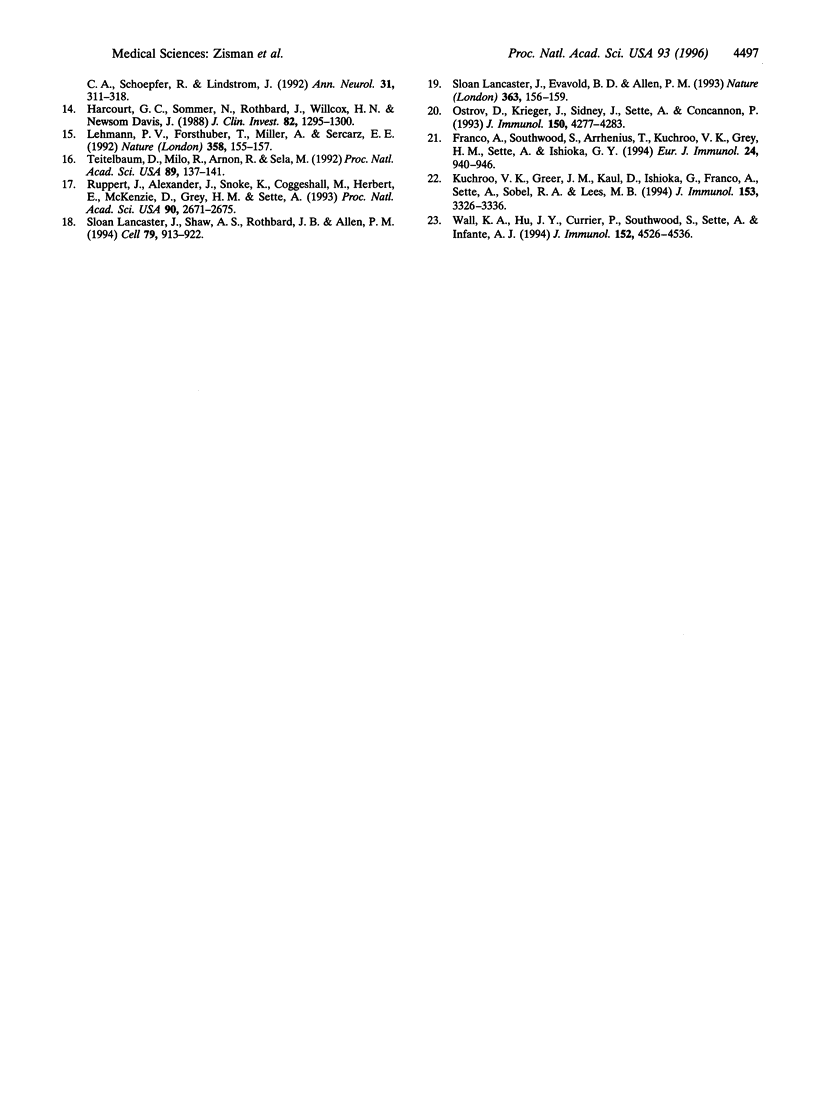Abstract
Myasthenia gravis is an autoimmune disease in which T cells specific to epitopes of the autoantigen, the human acetylcholine receptor, play a role. We identified two peptides, p195-212 and p259-271, from the alpha subunit of the receptor, which bound to major histocompatibility complex (MHC) class II molecules on antigen-presenting cells (APCs) from peripheral blood lymphocytes of myasthenia gravis patients and stimulated lymphocytes of >80% of the patients. We have prepared analogs of these myasthenogenic peptides and tested their ability to bind to MHC class II determinants and to interfere specifically with T-cell stimulation. We first determined relative binding efficiency of the myasthenogenic peptides and their analogs to APCs of patients. We found that single substituted analogs of p195-212 (Ala-207) and p259-271 (Lys-262) could bind to human MHC molecules on APCs as efficiently as the original peptides. Moreover, dual analogs containing the two single substituted analogs in one stretch (either sequentially, Ala-207/Lys-262, or reciprocally, Lys-262/Ala-207) could also bind to APCs of patients, including those that failed to bind one of the single substituted analogs. The single substituted analogs significantly inhibited T-cell stimulation induced by their respective myasthenogenic peptides in >95% of the patients. The dual analogs were capable of inhibiting stimulation induced by either of the peptides: They inhibited the response to p195-212 and p259-271 in >95% and >90% of the patients, respectively. Thus, the dual analogs are good candidates for inhibition of T-cell responses of myasthenia gravis patients and might have therapeutic potential.
Full text
PDF





Selected References
These references are in PubMed. This may not be the complete list of references from this article.
- Brocke S., Brautbar C., Steinman L., Abramsky O., Rothbard J., Neumann D., Fuchs S., Mozes E. In vitro proliferative responses and antibody titers specific to human acetylcholine receptor synthetic peptides in patients with myasthenia gravis and relation to HLA class II genes. J Clin Invest. 1988 Dec;82(6):1894–1900. doi: 10.1172/JCI113807. [DOI] [PMC free article] [PubMed] [Google Scholar]
- Compston D. A., Vincent A., Newsom-Davis J., Batchelor J. R. Clinical, pathological, HLA antigen and immunological evidence for disease heterogeneity in myasthenia gravis. Brain. 1980 Sep;103(3):579–601. doi: 10.1093/brain/103.3.579. [DOI] [PubMed] [Google Scholar]
- Drachman D. B. Myasthenia gravis. N Engl J Med. 1994 Jun 23;330(25):1797–1810. doi: 10.1056/NEJM199406233302507. [DOI] [PubMed] [Google Scholar]
- Franco A., Southwood S., Arrhenius T., Kuchroo V. K., Grey H. M., Sette A., Ishioka G. Y. T cell receptor antagonist peptides are highly effective inhibitors of experimental allergic encephalomyelitis. Eur J Immunol. 1994 Apr;24(4):940–946. doi: 10.1002/eji.1830240424. [DOI] [PubMed] [Google Scholar]
- Harcourt G. C., Sommer N., Rothbard J., Willcox H. N., Newsom-Davis J. A juxta-membrane epitope on the human acetylcholine receptor recognized by T cells in myasthenia gravis. J Clin Invest. 1988 Oct;82(4):1295–1300. doi: 10.1172/JCI113729. [DOI] [PMC free article] [PubMed] [Google Scholar]
- Hohlfeld R., Toyka K. V., Heininger K., Grosse-Wilde H., Kalies I. Autoimmune human T lymphocytes specific for acetylcholine receptor. Nature. 1984 Jul 19;310(5974):244–246. doi: 10.1038/310244a0. [DOI] [PubMed] [Google Scholar]
- Katz-Levy Y., Kirshner S. L., Sela M., Mozes E. Inhibition of T-cell reactivity to myasthenogenic epitopes of the human acetylcholine receptor by synthetic analogs. Proc Natl Acad Sci U S A. 1993 Aug 1;90(15):7000–7004. doi: 10.1073/pnas.90.15.7000. [DOI] [PMC free article] [PubMed] [Google Scholar]
- Kuchroo V. K., Greer J. M., Kaul D., Ishioka G., Franco A., Sette A., Sobel R. A., Lees M. B. A single TCR antagonist peptide inhibits experimental allergic encephalomyelitis mediated by a diverse T cell repertoire. J Immunol. 1994 Oct 1;153(7):3326–3336. [PubMed] [Google Scholar]
- Lehmann P. V., Forsthuber T., Miller A., Sercarz E. E. Spreading of T-cell autoimmunity to cryptic determinants of an autoantigen. Nature. 1992 Jul 9;358(6382):155–157. doi: 10.1038/358155a0. [DOI] [PubMed] [Google Scholar]
- Melms A., Chrestel S., Schalke B. C., Wekerle H., Mauron A., Ballivet M., Barkas T. Autoimmune T lymphocytes in myasthenia gravis. Determination of target epitopes using T lines and recombinant products of the mouse nicotinic acetylcholine receptor gene. J Clin Invest. 1989 Mar;83(3):785–790. doi: 10.1172/JCI113958. [DOI] [PMC free article] [PubMed] [Google Scholar]
- Melms A., Malcherek G., Gern U., Wiethölter H., Müller C. A., Schoepfer R., Lindstrom J. T cells from normal and myasthenic individuals recognize the human acetylcholine receptor: heterogeneity of antigenic sites on the alpha-subunit. Ann Neurol. 1992 Mar;31(3):311–318. doi: 10.1002/ana.410310314. [DOI] [PubMed] [Google Scholar]
- Mozes E., Dayan M., Zisman E., Brocke S., Licht A., Pecht I. Direct binding of a myasthenia gravis related epitope to MHC class II molecules on living murine antigen-presenting cells. EMBO J. 1989 Dec 20;8(13):4049–4052. doi: 10.1002/j.1460-2075.1989.tb08588.x. [DOI] [PMC free article] [PubMed] [Google Scholar]
- Ostrov D., Krieger J., Sidney J., Sette A., Concannon P. T cell receptor antagonism mediated by interaction between T cell receptor junctional residues and peptide antigen analogues. J Immunol. 1993 May 15;150(10):4277–4283. [PubMed] [Google Scholar]
- Protti M. P., Manfredi A. A., Straub C., Howard J. F., Jr, Conti-Tronconi B. M. Immunodominant regions for T helper-cell sensitization on the human nicotinic receptor alpha subunit in myasthenia gravis. Proc Natl Acad Sci U S A. 1990 Oct;87(19):7792–7796. doi: 10.1073/pnas.87.19.7792. [DOI] [PMC free article] [PubMed] [Google Scholar]
- Ruppert J., Alexander J., Snoke K., Coggeshall M., Herbert E., McKenzie D., Grey H. M., Sette A. Effect of T-cell receptor antagonism on interaction between T cells and antigen-presenting cells and on T-cell signaling events. Proc Natl Acad Sci U S A. 1993 Apr 1;90(7):2671–2675. doi: 10.1073/pnas.90.7.2671. [DOI] [PMC free article] [PubMed] [Google Scholar]
- Sloan-Lancaster J., Evavold B. D., Allen P. M. Induction of T-cell anergy by altered T-cell-receptor ligand on live antigen-presenting cells. Nature. 1993 May 13;363(6425):156–159. doi: 10.1038/363156a0. [DOI] [PubMed] [Google Scholar]
- Sloan-Lancaster J., Shaw A. S., Rothbard J. B., Allen P. M. Partial T cell signaling: altered phospho-zeta and lack of zap70 recruitment in APL-induced T cell anergy. Cell. 1994 Dec 2;79(5):913–922. doi: 10.1016/0092-8674(94)90080-9. [DOI] [PubMed] [Google Scholar]
- Teitelbaum D., Milo R., Arnon R., Sela M. Synthetic copolymer 1 inhibits human T-cell lines specific for myelin basic protein. Proc Natl Acad Sci U S A. 1992 Jan 1;89(1):137–141. doi: 10.1073/pnas.89.1.137. [DOI] [PMC free article] [PubMed] [Google Scholar]
- Waldor M. K., Sriram S., McDevitt H. O., Steinman L. In vivo therapy with monoclonal anti-I-A antibody suppresses immune responses to acetylcholine receptor. Proc Natl Acad Sci U S A. 1983 May;80(9):2713–2717. doi: 10.1073/pnas.80.9.2713. [DOI] [PMC free article] [PubMed] [Google Scholar]
- Wall K. A., Hu J. Y., Currier P., Southwood S., Sette A., Infante A. J. A disease-related epitope of Torpedo acetylcholine receptor. Residues involved in I-Ab binding, self-nonself discrimination, and TCR antagonism. J Immunol. 1994 May 1;152(9):4526–4536. [PubMed] [Google Scholar]
- Zhang Y., Schluep M., Frutiger S., Hughes G. J., Jeannet M., Steck A., Barkas T. Immunological heterogeneity of autoreactive T lymphocytes against the nicotinic acetylcholine receptor in myasthenic patients. Eur J Immunol. 1990 Dec;20(12):2577–2583. doi: 10.1002/eji.1830201208. [DOI] [PubMed] [Google Scholar]
- Zisman E., Brautbar C., Sela M., Abramsky O., Battat S., Kirshner S. L., Katz-Levy Y., Dayan M., Mozes E. Binding of peptides of the human acetylcholine receptor alpha-subunit to HLA class II of patients with myasthenia gravis. Hum Immunol. 1995 Nov;44(3):121–130. doi: 10.1016/0198-8859(95)00094-1. [DOI] [PubMed] [Google Scholar]
- Zisman E., Dayan M., Sela M., Mozes E. Ia-antigen-T-cell interactions for a thymus-independent antigen composed of D amino acids. Proc Natl Acad Sci U S A. 1993 Feb 1;90(3):994–998. doi: 10.1073/pnas.90.3.994. [DOI] [PMC free article] [PubMed] [Google Scholar]


